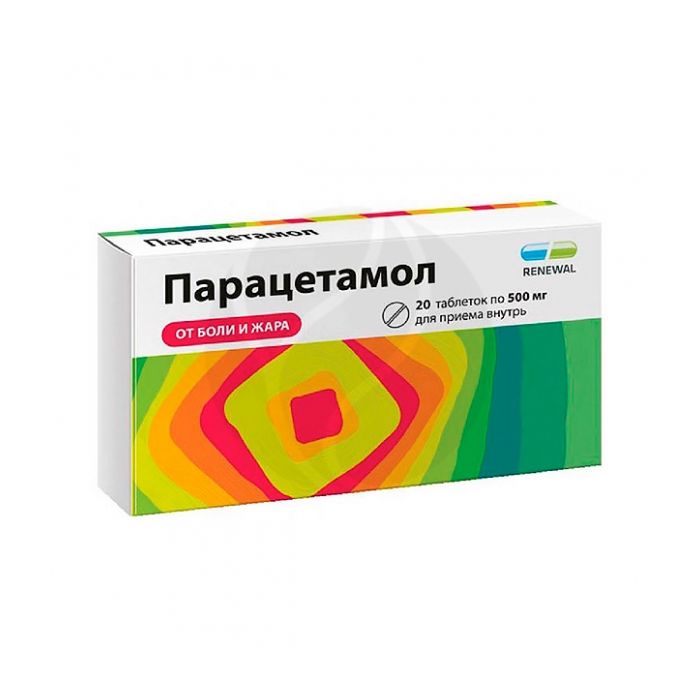Paracetamol tablets, No. 20
Expiration Date: 05/2027
Russian Pharmacy name:
Парацетамол таблетки, №20
Anesthetic for mild to moderate pain syndrome:
arthralgia,
myalgia,
neuralgia,
migraine,
headache and toothache.
An antipyretic agent for acute respiratory diseases and other infectious and inflammatory diseases, accompanied by an increase in body temperature.
Administered orally with a large amount of liquid, 0.5 g-1 g 2-3 times after meals.
Do not exceed the indicated dose in the instructions. An increase in the daily dose of paracetamol and the duration of treatment is possible only under the supervision of a doctor.
1 tablet contains:
active substance:
paracetamol - 0.5 g
Excipients:
potato starch - 0.0280 g
stearic acid - 0.0011 g
low molecular weight povidone - 0.0165 g
magnesium stearate - 0.0044 g
Hypersensitivity to paracetamol.
Children under 8 years old.
Carefully
Renal and hepatic failure, benign hyperbilirubinemia (including Gilbert's syndrome), viral hepatitis, alcoholic liver damage, alcoholism, pregnancy, lactation, old age, glucose-6-phosphate dehydrogenase deficiency.
INN
Paracetamol
Dosage form
Pills
Dosage
500 mg
Release form
No. 20
Composition
1 tablet contains:
active substance:
paracetamol - 0.5 g
Excipients:
potato starch - 0.0280 g
stearic acid - 0.0011 g
low molecular weight povidone - 0.0165 g
magnesium stearate - 0.0044 g
Pharmacotherapeutic group
Analgesic non-narcotic drug
Pharmacodynamics:
Paracetamol has antipyretic and analgesic effects. The non-narcotic analgesic blocks cyclooxygenase (COX) I and II, mainly in the central nervous system, affecting the centers of pain and thermoregulation. In inflamed tissues, cellular peroxidases neutralize the effect of paracetamol on COX, which explains the almost complete absence of the anti-inflammatory effect. Since paracetamol has an extremely small effect on the synthesis of prostaglandins in peripheral tissues, it does not change water-electrolyte metabolism and does not cause damage to the mucous membrane of the gastrointestinal tract.Thus, paracetamol is especially suitable for patients with a history of gastrointestinal tract diseases (such as in patients with a history of gastrointestinal bleeding or in elderly patients) or patients taking concomitant medications when inhibition of peripheral prostaglandins may be undesirable.
Pharmacokinetics:
Absorption
Absorption - a high drug is rapidly and almost completely absorbed from the gastrointestinal tract. “Cmax is reached in 05-2 hours; Cmax - 5-20 ?g / ml. Communication with plasma proteins - 15%. Penetrates the blood-brain barrier. Less than 1% of the dose of paracetamol taken by a nursing mother passes into breast milk. The therapeutically effective concentration of paracetamol in plasma is achieved when it is administered at a dose of 10-15 mg / kg.
Metabolism
It is metabolized in the liver (90-95%): 80% enters into conjugation reactions with glucuronic acid and sulfates to form inactive metabolites; 17% undergoes hydroxylation to form 8 active metabolites, which are conjugated with glutathione to form already inactive metabolites. With a lack of glutathione, these metabolites can block the enzyme systems of hepatocytes and cause their necrosis. The metabolism of the drug also involves CYP2E1 CYP1A2 isoenzymes and, to a lesser extent, CYP3A4 isoenzyme. Additional metabolic pathways are hydroxylation to 3-hydroxyparacetamol and methoxylation to 3-methoxyparacetamol, which are subsequently conjugated to glucuronides or sulfates. In adults, glucuronidation predominates in newborns (including premature babies) and in young children - sulfation.Conjugated paracetamol metabolites (glucuronides sulfates and conjugates with glutathione) have low pharmacological (including toxic) activity.
Withdrawal
The half-life (T1 / 2) is 1-4 hours. It is excreted by the kidneys in the form of metabolites, mainly conjugates, only 3% unchanged. In elderly patients, paracetamol clearance decreases and the half-life increases.
Indications for use
Anesthetic for mild to moderate pain syndrome:
arthralgia,
myalgia,
neuralgia,
migraine,
headache and toothache.
An antipyretic agent for acute respiratory diseases and other infectious and inflammatory diseases, accompanied by an increase in body temperature.
Method of administration and dosage
Administered orally with a large amount of liquid, 0.5 g-1 g 2-3 times after meals.
Do not exceed the indicated dose in the instructions. An increase in the daily dose of paracetamol and the duration of treatment is possible only under the supervision of a doctor.
Contraindications
Hypersensitivity to paracetamol. Children under 8 years old.
Side effect
Nausea, vomiting, epigastric pain, allergic reactions (skin rash, itching, urticaria, Quincke's edema). Rarely - anemia, leukopenia, thrombocytopenia, agranulocytosis.
Carefully
Renal and hepatic failure, benign hyperbilirubinemia (including Gilbert's syndrome), viral hepatitis, alcoholic liver damage, alcoholism, pregnancy, lactation, old age, glucose-6-phosphate dehydrogenase deficiency.
Overdose
Symptoms: during the first 24 hours after administration - pallor of the skin, nausea, vomiting, anorexia, abdominal pain; violation of glucose metabolism, metabolic acidosis. Symptoms of liver dysfunction may appear 12-48 hours after an overdose. In severe overdose - liver failure with progressive encephalopathy, coma, death; acute renal failure with tubular necrosis (including in the absence of severe liver damage); arrhythmia, pancreatitis. The hepatotoxic effect in adults is manifested when taking 10 g or more.
Treatment: the introduction of donors of SH-groups and precursors of the synthesis of glutathione - methionine 8-9 hours after the overdose and N-acetylcysteine ??- after 12 hours. The need for additional therapeutic measures (further administration of methionine, IV administration of N-acetylcysteine) is determined in depending on the concentration of paracetamol in the blood, as well as on the time elapsed after taking it.
Interaction with other medicinal products
Stimulants of microsomal oxidation in the liver (phenytoin, ethanol, barbiturates, rifampicin, phenylbutazone, tricyclic antidepressants), ethanol and hepatotoxic drugs increase the production of hydroxylated active metabolites, which makes it possible to develop severe intoxication with small overdoses. Long-term use of barbiturates reduces the effectiveness of paracetamol.
Storage conditions:
At a temperature not higher than 30 ? C.
Keep out of the reach of children.
Shelf life:
3 years.
Do not use after the expiration date.
Vacation conditions
Without recipe

